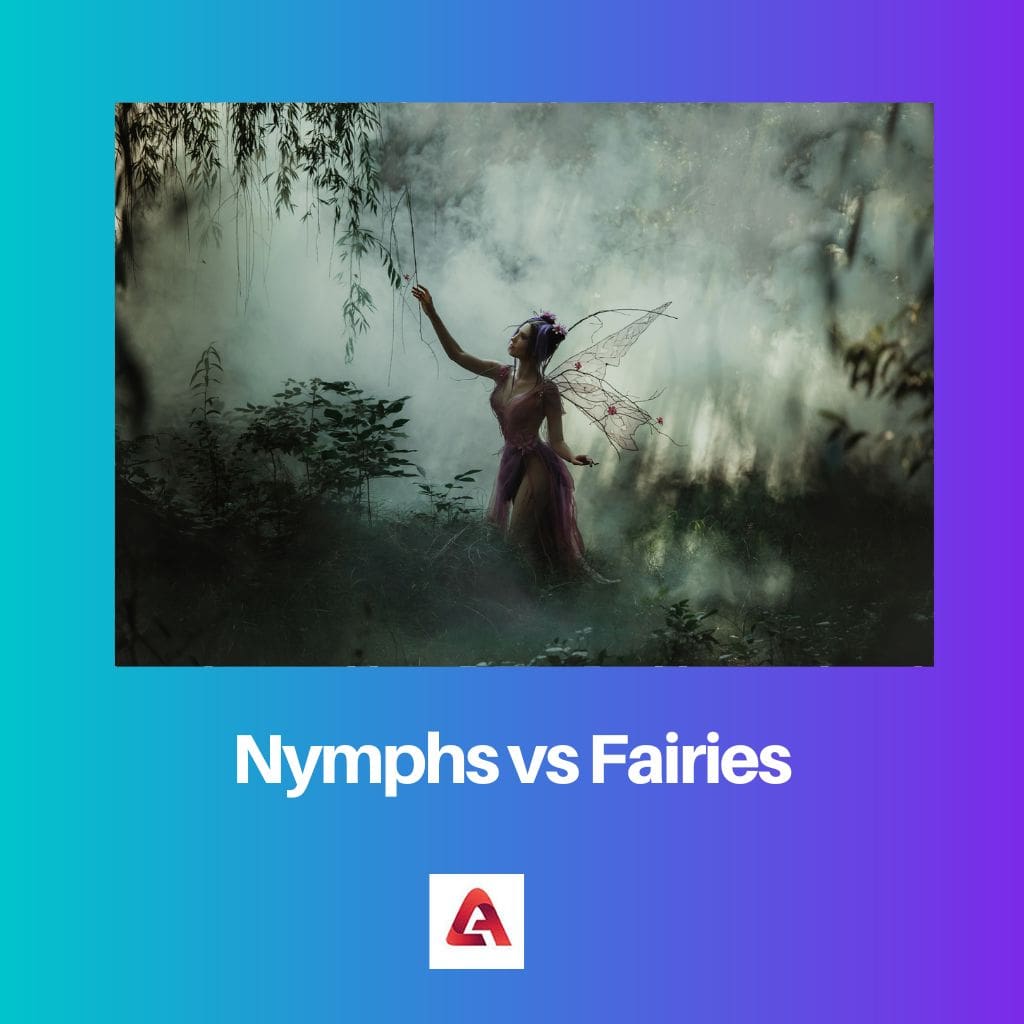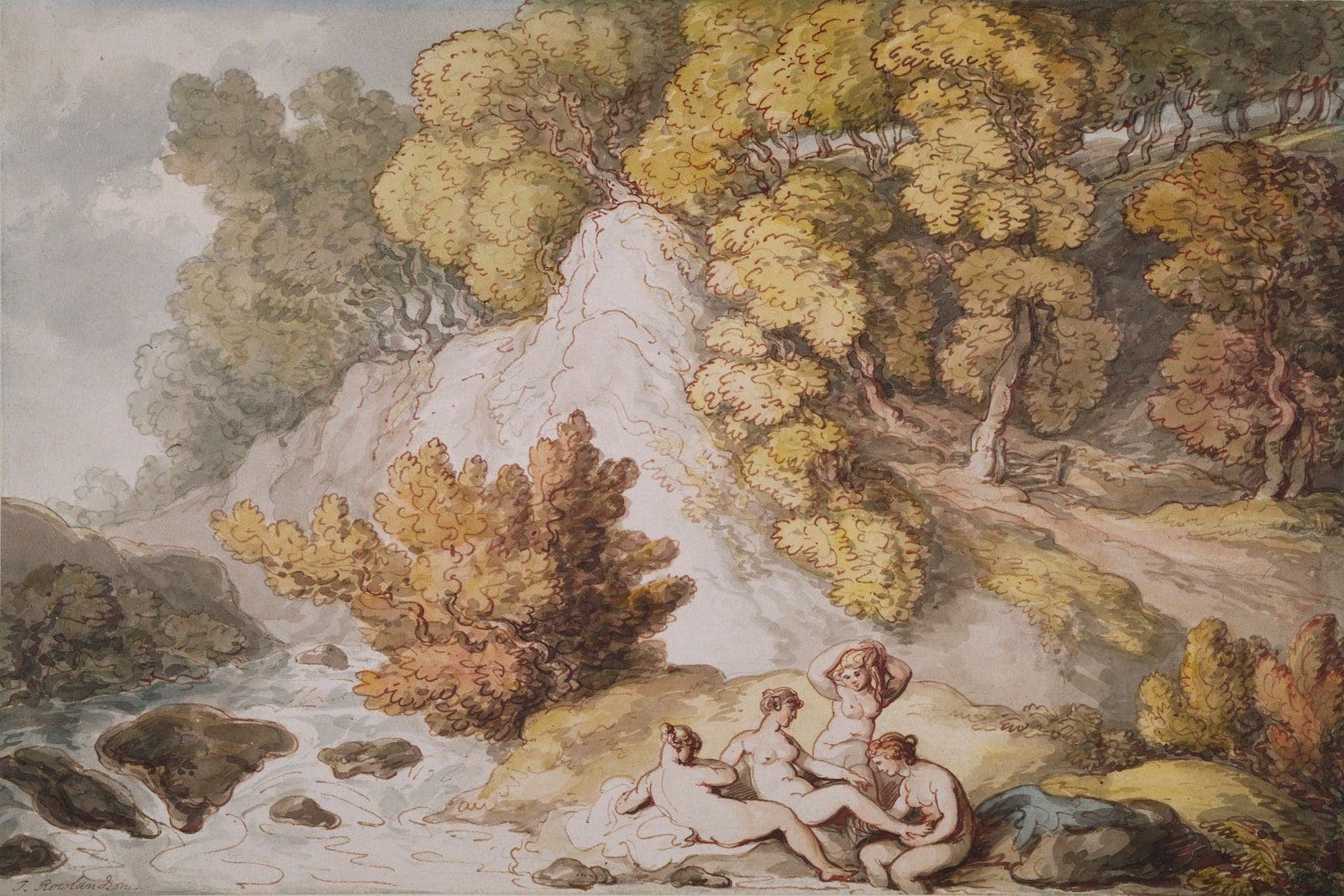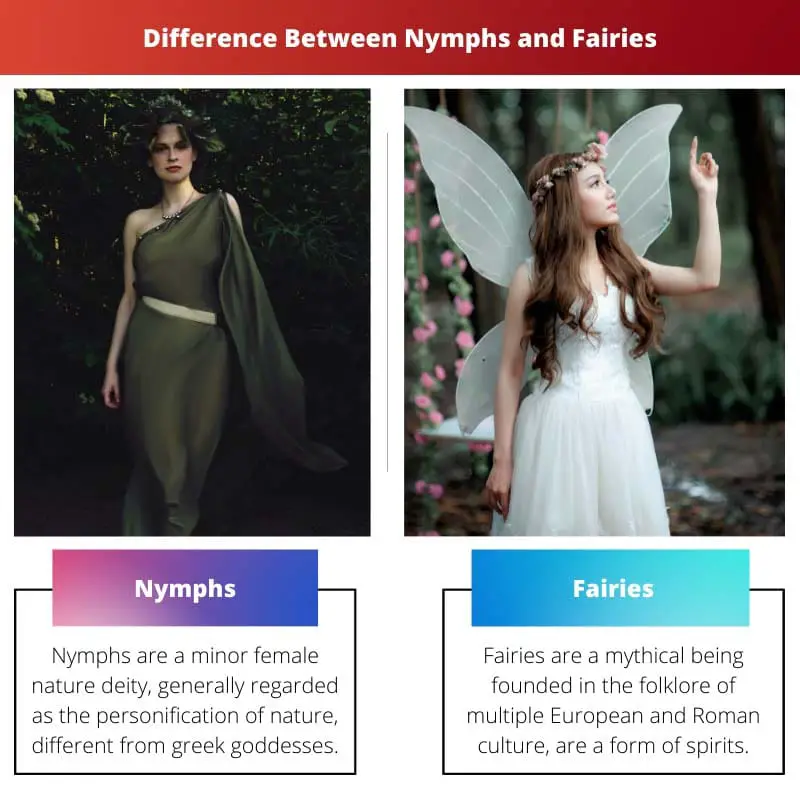Nymphs, embodiments of nature’s essence, exude an ethereal grace, their presence a harmonious symphony with the earth’s rhythms. Fairies, mischievous and spirited, dance on the fringes of reality, weaving enchantment with their whimsical mischief and glittering wings, inviting mortals into realms of wonder and fantasy.
Key Takeaways
- Nymphs are female nature spirits who live in natural habitats such as mountains, forests, and rivers.
- Fairies are magical creatures that possess supernatural powers and are associated with enchantment, beauty, and grace.
- While nymphs are depicted as human-like beings with wings, fairies are tiny, magical creatures with wings and a wand.
Nymphs vs. Fairies
Nymph is a Greek mythology. They are female species. They look like humans. They can be found in woods, lands, or mountains. They have a long life. Fairy is Roman mythology. A fairy can be a male or a female. They are very small in size. They also look like humans. People believe that fairies have magical powers.

Nymph is a mythological spirit of nature imagined as a beautiful maiden inhabiting woods, rivers, and mountains. They are human-like female species.
Very adolescent, beautiful females always take them. The word nymph is derived from the greed word ‘nymphe’.
They are considered divine spirits with nature. Fairies are small imaginary being of human that has magical powers.
They are very tiny, approximately a size of a thumb. They can be male or female and regarded as wise and benevolent creatures.
The evolution of fairies witnesses a negative impression on the people of the past. It was believed that they caused bad luck and were mischievous creatures.
Comparison Table
| Feature | Nymphs | Fairies |
|---|---|---|
| Origin | Greek Mythology | Celtic and Germanic folklore, various European cultures |
| Nature | Minor nature deities associated with specific natural features (e.g., water, mountains, trees) | Small, magical creatures with diverse characteristics and abilities |
| Appearance | Usually depicted as beautiful young women | Variable, depicted as small and winged, with human-like features but sometimes more whimsical or mischievous |
| Size | Human-sized | Usually very small, ranging from insect-sized to human-child sized |
| Powers | Often associated with specific abilities related to their element or domain (e.g., water nymphs control water) | Diverse range of magical abilities, such as flight, illusion, shapeshifting, and trickery |
| Temperament | Can be benevolent or mischievous, depending on the specific nymph and the circumstances | Can be helpful, mischievous, or even dangerous, depending on the specific fairy and the individual story |
| Society | Often solitary or live in small groups | Can live in organized communities or be solitary |
| Relationship with humans | Can be seen as protectors, guides, or even lovers of humans | Can interact with humans in various ways, from helpful to mischievous or even dangerous |
What are Nymphs?
Nymphs, originating from ancient Greek mythology, are supernatural beings associated with natural landscapes such as forests, mountains, rivers, and springs. They are considered lesser deities or spirits, depicted as beautiful maidens with a deep connection to their respective domains. Nymphs were believed to embody the essence and spirit of nature, serving as guardians and caretakers of their environments.
Types and Varieties
- Dryads: Nymphs of the trees and forests, closely linked with the vitality and life force of wooded areas.
- Naiads: Nymphs of freshwater bodies such as rivers, streams, and lakes, revered as protectors of water sources and sources of inspiration for poets and artists.
- Oreads: Nymphs of the mountains and grottoes, depicted as free-spirited beings roaming the rugged landscapes of the high peaks.
- Nereids: Sea nymphs inhabiting the depths of the oceans, depicted as graceful and alluring figures, accompanying sea gods like Poseidon.
Role and Influence
Nymphs played significant roles in Greek mythology and were depicted as companions to gods and heroes or as objects of desire in various myths and legends. They were believed to possess eternal youth and beauty, captivating mortals and immortals alike with their enchanting presence. Nymphs were also associated with fertility rites and rituals, symbolizing the renewal and abundance of the natural world.

What are Fairies?
Fairies are mystical beings deeply ingrained in folklore and mythology across various cultures, with roots tracing back centuries. Originating predominantly from Celtic and European folklore, fairies are believed to inhabit enchanted realms beyond the mundane world, associated with forests, meadows, and other natural landscapes. These diminutive supernatural beings are known for their magical abilities, mischievous antics, and close ties to the natural world.
Characteristics and Diversity
Fairies are depicted in a myriad of forms and attributes, ranging from benevolent guardians of nature to tricksters with a penchant for mischief. Common characteristics include small stature, ethereal beauty, and the possession of magical powers such as flight, shape-shifting, and enchantment. Despite their diverse appearances and dispositions, fairies share a common association with the mystical and the fantastical, captivating the imaginations of storytellers, artists, and audiences alike.
Cultural Depictions and Influence
Throughout history, fairies have been prominent figures in literature, folklore, and popular culture, appearing in countless tales, poems, and legends. From the mischievous sprites of Shakespearean plays to the benevolent protectors of Irish mythology, fairies have left an indelible mark on the collective imagination of humanity. Their portrayal in literature, art, and media reflects the evolving perceptions of the supernatural and the enduring fascination with the enchanted realms beyond the confines of everyday reality.

Main Differences Between Nymphs and Fairies
- Origins and Cultural Background:
- Nymphs primarily originate from Greek mythology and are associated with natural landscapes like forests, rivers, and mountains.
- Fairies, on the other hand, have roots in Celtic and European folklore and are linked to enchanted realms beyond the mundane world.
- Characteristics and Attributes:
- Nymphs are depicted as graceful, ethereal beings closely connected to their respective natural domains, embodying specific elements such as trees (dryads) or water (naiads).
- Fairies are portrayed as diminutive supernatural creatures with magical abilities, ranging from benevolent guardians of nature to mischievous tricksters, and are commonly associated with forests, meadows, and other mystical landscapes.
- Cultural Depictions and Influence:
- Nymphs have been significant figures in Greek mythology and have inspired works of literature, art, and music, symbolizing the enduring connection between humanity and the natural world.
- Fairies have played prominent roles in folklore, literature, and popular culture, captivating imaginations with their magical abilities and mysterious allure, influencing beliefs about nature, spirituality, and the supernatural.
- Association and Symbolism:
- Nymphs are associated with themes of fertility, renewal, and the cycle of life, serving as guardians and caretakers of their respective natural domains.
- Fairies embody themes of wonder, enchantment, and the unseen forces of the mystical realms, symbolizing humanity’s fascination with the supernatural and the unknown.



